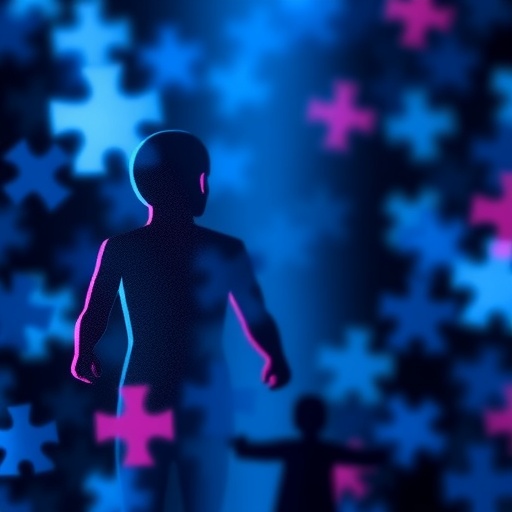In a groundbreaking study poised to challenge existing paradigms around autism spectrum disorder (ASD), researchers from the University of Cambridge have uncovered compelling evidence that the genetic architecture and developmental trajectories of autism vary notably depending on the age at which an individual is diagnosed. This revelation questions the long-standing assumption that autism represents a single, unified neurodevelopmental condition. Instead, it suggests the presence of distinct biological underpinnings that manifest across different stages of development.
The extensive study, recently published in the prestigious journal Nature, harnessed a vast international consortium of data, encompassing behavioral assessments from children and adolescents in the United Kingdom and Australia, as well as genetic profiles from over 45,000 autistic individuals sourced across multiple European and American cohorts. This unprecedented scale allowed for a nuanced analysis that bridges developmental timelines with genomic intricacies, offering a panoramic view of autism’s heterogeneity.
Initial behavioral analyses revealed that individuals diagnosed with autism before the age of six commonly exhibit early life challenges, particularly in social communication domains. These children frequently present with overt difficulties that are identifiable in infancy or toddlerhood, including impaired social reciprocity and early communication deficits. These early manifestations often lead to diagnosis during preschool years, prompting timely intervention.
Conversely, the cohort diagnosed later—typically in late childhood or adolescence—displayed a markedly different pattern. Their social and behavioral issues were less apparent during early development but became prominent in adolescence, often accompanied by heightened social withdrawal, behavioral challenges, and increased vulnerability to psychiatric comorbidities. Notably, conditions such as attention deficit hyperactivity disorder (ADHD), depression, and post-traumatic stress disorder (PTSD) appeared more frequently within this group, underscoring a complex clinical picture that extends beyond classic autism symptomatology.
The genomic dimension added a provocative layer to these findings. Through the analysis of polygenic risk scores (PRS)—which aggregate the influence of thousands of small-effect genetic variants—the research team delineated two partially overlapping but fundamentally divergent genetic profiles correlated with early and late diagnoses. Significantly, the genetic signature associated with later-diagnosed autism bore greater resemblance to risk profiles for ADHD, depression, and PTSD, suggesting shared genetic susceptibilities beyond those traditionally linked to early-onset autism.
This polygenic disparity implies that the timing of diagnosis reflects intrinsic biological differences rather than being solely attributable to external factors like access to healthcare or diagnostic practices. While social and environmental components, including the impact of early support—or lack thereof—undoubtedly modulate outcomes, the discovery of these genetic distinctions reframes autism as a spectrum comprising multiple discrete conditions with varied etiologies.
“The distinct developmental trajectories we observed showcase that autism is not a monolithic entity,” explained Dr. Xinhe Zhang, the lead author from Cambridge’s Department of Psychiatry. “Our data suggest that some individuals carry genetic variants that predispose them to express autistic traits visibly in early childhood, facilitating earlier detection and diagnosis. Meanwhile, others possess genetic factors that modulate the emergence and expression of autism traits later in childhood or adolescence.”
Significantly, the study elucidated that these polygenic factors account for approximately 11% of the variance in age at autism diagnosis, a substantial figure in the realm of complex traits, indicating robust heritable contributions. The authors caution, however, that diagnosis age is a gradient rather than sharply divided categories, highlighting overlap and fluidity in presentations.
Senior author Dr. Varun Warrier pointed out, “The implication here is profound: understanding autism’s biology necessitates acknowledging its multifaceted nature. Earlier and later diagnosed individuals not only follow different developmental paths but carry different genetic loadings that influence which autism features surface and when.”
Beyond expanding scientific knowledge, these insights bear practical clinical significance. Recognizing that autism encompasses distinct subtypes differentiated by developmental timing and genetics can inform more tailored diagnostic frameworks and intervention strategies. For example, adolescents presenting with social and behavioral difficulties alongside mental health comorbidities may benefit from screening approaches sensitive to late-emerging autism profiles that are distinct from early childhood forms.
Moreover, the findings highlight the critical interplay between genetics and environment, suggesting future research avenues to unravel how social exposure, educational support, and mental health resources interact with genetic predispositions to shape long-term outcomes. The vulnerability of those diagnosed later underscores the importance of enhanced awareness among caregivers and professionals about the varied presentations of autism across developmental stages.
As autism research moves toward precision medicine, this study lays important groundwork. It advocates for shifting from treating autism as a uniform diagnosis to a framework appreciating its heterogeneity, potentially revolutionizing clinical pathways, support systems, and therapeutic interventions tailored to individual developmental and genetic contexts.
Looking forward, the research team emphasizes the necessity for continued interdisciplinary investigations that integrate genomics, developmental psychology, and psychiatry. Such efforts are essential to fully map the diverse biological and social landscapes underlying autism’s spectrum and to optimize support for autistic individuals across the lifespan.
In sum, this landmark investigation challenges conventional autism models, unveiling a complex mosaic of genetic and developmental factors that disparate timing of diagnosis brings to light. It boldly asserts that autism, as currently conceived, comprises multiple intertwined conditions, each with its own trajectory, genetic signature, and clinical needs—a revelation with significant ramifications for science, medicine, and society.
Subject of Research: Genetic and developmental heterogeneity of autism spectrum disorder based on age at diagnosis
Article Title: Polygenic and developmental profiles of autism differ by age at diagnosis
News Publication Date: 1-Oct-2025
Web References:
- University of Cambridge Autism Research Centre
- University of Cambridge Neurodevelopmental Research Group
- DOI link: 10.1038/s41586-025-09542-6
References:
Zhang, X., Grove, J., Gu, Y., Buus, C. K., Nielsen, L. K., Neufeld, S. A. S., et al. (2025). Polygenic and developmental profiles of autism differ by age at diagnosis. Nature. https://doi.org/10.1038/s41586-025-09542-6
Keywords: autism spectrum disorder, age at diagnosis, polygenic risk scores, genetic heterogeneity, neurodevelopment, ADHD, depression, PTSD, early diagnosis, late diagnosis, developmental trajectories, psychiatric comorbidity, genomics




